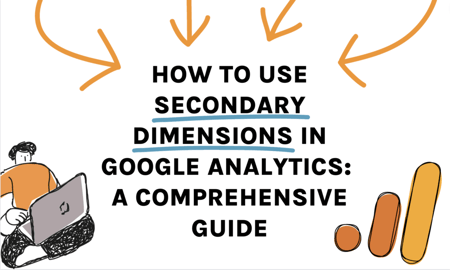Enhance Your Data Evaluation Using Additional Measurements
The true deepness of understandings lies in the integration of secondary dimensions. The tactical usage of additional measurements raises evaluation beyond the surface level, guaranteeing a riches of untapped possible waiting to be discovered.
Recognizing Additional Dimensions
Second dimensions in data evaluation describe added features or metrics that offer deeper insights when integrated with primary data measurements, enhancing the overall understanding of the dataset. These added measurements offer a more detailed sight of the information, enabling analysts to reveal concealed patterns, partnerships, and fads that may not be obvious when just considering primary measurements.
By including additional dimensions right into data evaluation, experts can gain an extra nuanced understanding of the variables influencing the key metrics. For instance, in marketing analysis, key measurements can include fundamental consumer demographics like age and sex, while second measurements might include variables such as buying behavior, preferences, or geographic location. By combining these secondary and main measurements, experts can develop a lot more thorough customer profiles, making it possible for more targeted and reliable advertising techniques.
Additionally, secondary dimensions can help in determining relationships between various variables, leading to more exact anticipating modeling and decision-making. They allow experts to check out information from multiple viewpoints, enriching the understandings drawn from the dataset and eventually improving the quality of analysis and calculated suggestions.
Advantages of Second Measurements
When thinking about information evaluation, integrating second dimensions offers a wide variety of advantages that significantly improve the deepness and breadth of insights originated from key data dimensions. One of the crucial benefits of second measurements is the capability to offer context to main information. By adding secondary dimensions such as time, place, or market information to the analysis, scientists can obtain a more extensive understanding of the key information factors - secondary dimensions. This contextual details can help determine patterns, fads, and connections that may have or else gone unnoticed.
Moreover, second dimensions can likewise aid in segmenting information, allowing for a more comprehensive evaluation of specific subsets within the key data. This division can result in more targeted methods and activities based on the distinct qualities of each section. Additionally, additional dimensions can help in verifying searchings for from main data measurements, providing a much more durable and reputable basis for decision-making.
Essentially, the benefits of including secondary measurements right into data evaluation are vital, supplying richer understandings and making it possible for even more informed decision-making processes.
Implementing Additional Measurements Successfully
When incorporating additional measurements, it is vital to align them with the primary measurements to acquire much deeper understandings right into the information. It is crucial to pick additional dimensions that enhance the key information without triggering sound or confusion in the evaluation.
Furthermore, think about the scalability of the second measurements across various datasets or evaluations. By implementing second dimensions properly, experts can enhance the depth and precision of their information analysis, leading to even more informed decision-making and actionable insights.
Advanced Techniques With Additional Measurements
For a much more innovative approach to data analysis, incorporating additional measurements can considerably elevate the deepness of understandings gained. Advanced learn the facts here now techniques with additional dimensions involve more complex approaches to extract valuable details from data sets. One such strategy is friend analysis, where data is segmented based upon particular qualities or actions to track patterns with time. This approach enables a deeper understanding of how various teams engage and advance with your service or product.
One more advanced strategy is regression evaluation, which assists recognize relationships in between variables and how they influence each various other. By adding second measurements, such as demographic details or customer actions, to regression models, you can uncover a lot more nuanced understandings and make even more precise forecasts.

Study: Additional Dimensions in Action

In an additional circumstance, a doctor leveraged additional measurements to maximize resource allowance. By analyzing patient outcomes in regard to geographical area, the company determined locations with high readmission rates. This brought about the implementation of targeted treatment programs in those regions, inevitably improving person treatment and minimizing health care prices.
These case studies highlight the power of additional measurements in revealing useful insights that drive tactical decision-making. By delving deeper into data analysis beyond main metrics, organizations can get a much more thorough understanding of their procedures and customers, causing even more efficient and educated organization strategies.
Final Thought
Finally, the unification of secondary measurements in information analysis is essential for obtaining an extensive understanding of underlying variables and fads. By using strategies such as mate evaluation and regression evaluation, organizations can reveal surprise insights and make more informed choices. Second dimensions add deepness and breadth to data analysis, enabling organizations to explore data from numerous viewpoints and drive extra efficient outcomes.
In marketing evaluation, main measurements could look at this website consist of fundamental consumer demographics like age and sex, while second dimensions might incorporate variables such as buying behavior, preferences, or geographic location.When considering information analysis, incorporating additional measurements provides a multitude of advantages that substantially improve the depth and breadth of insights obtained from main information dimensions.Furthermore, second measurements can additionally assist in segmenting information, permitting for an extra thorough evaluation of details parts within the main information. In addition, additional dimensions can help in confirming findings from key information measurements, offering an extra durable and trusted basis for decision-making.
When incorporating second measurements, it is essential to align them with the main measurements to get much deeper understandings right into the information.